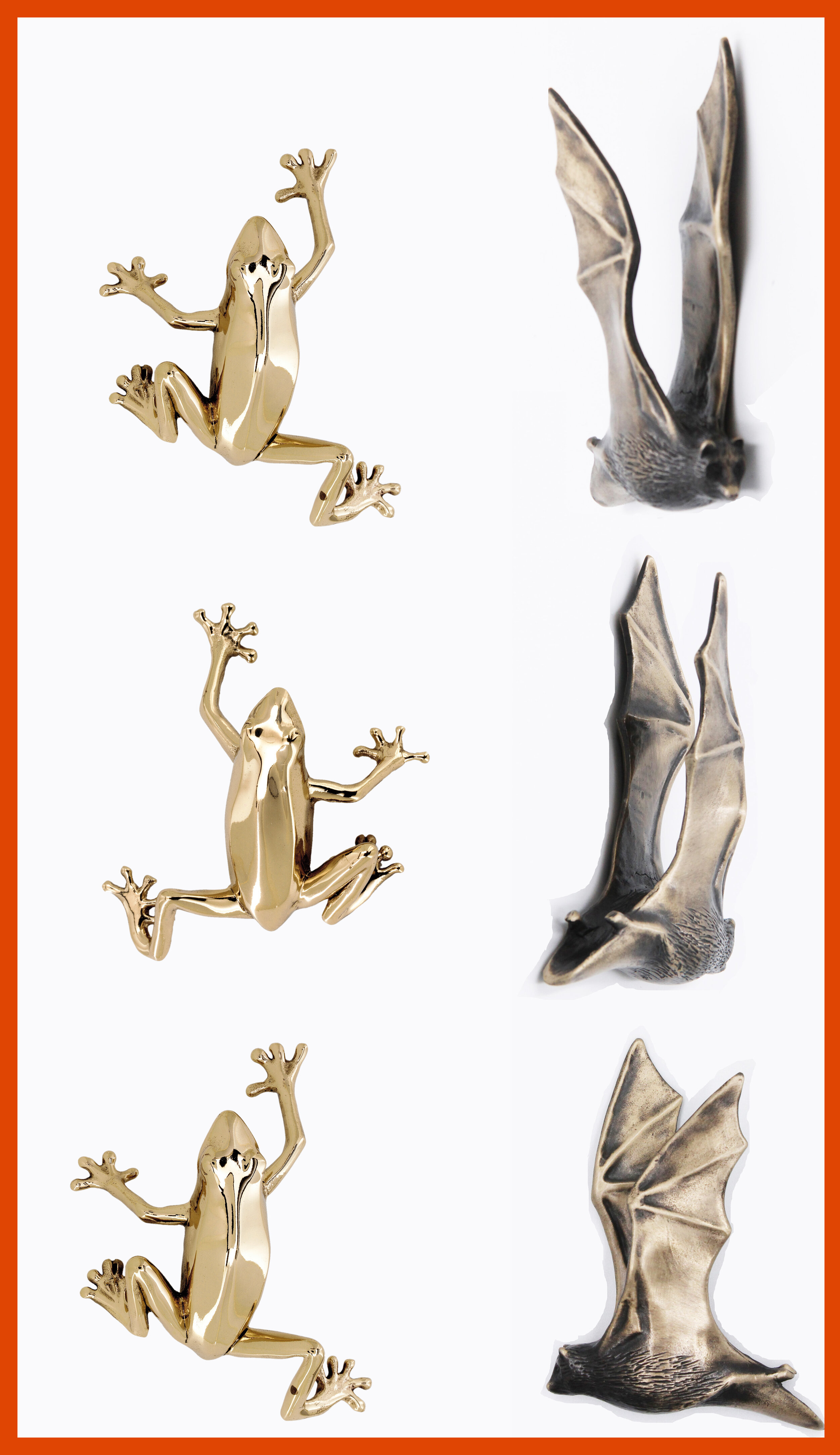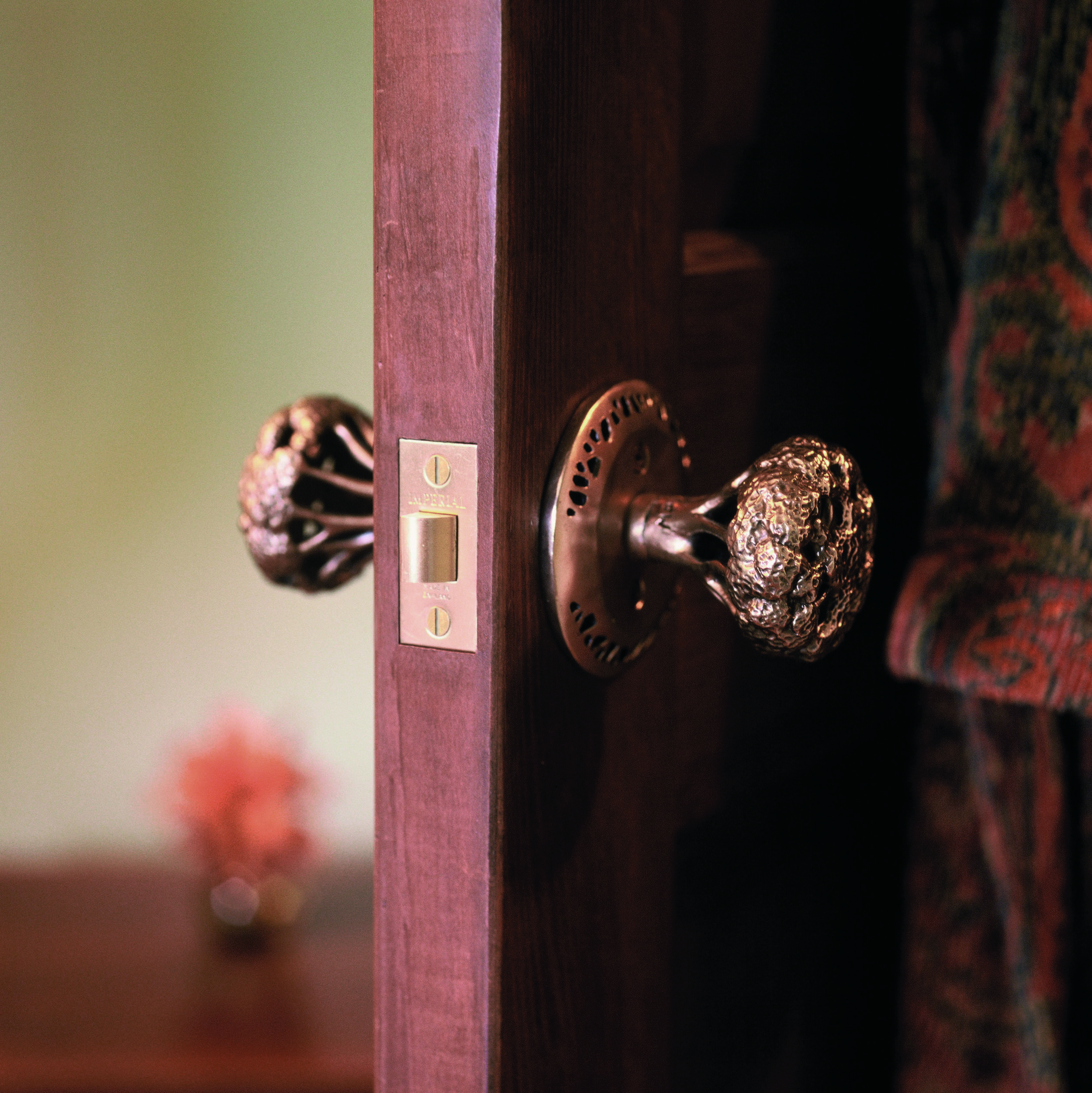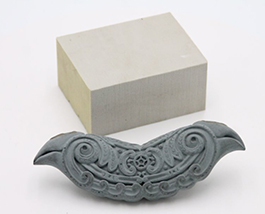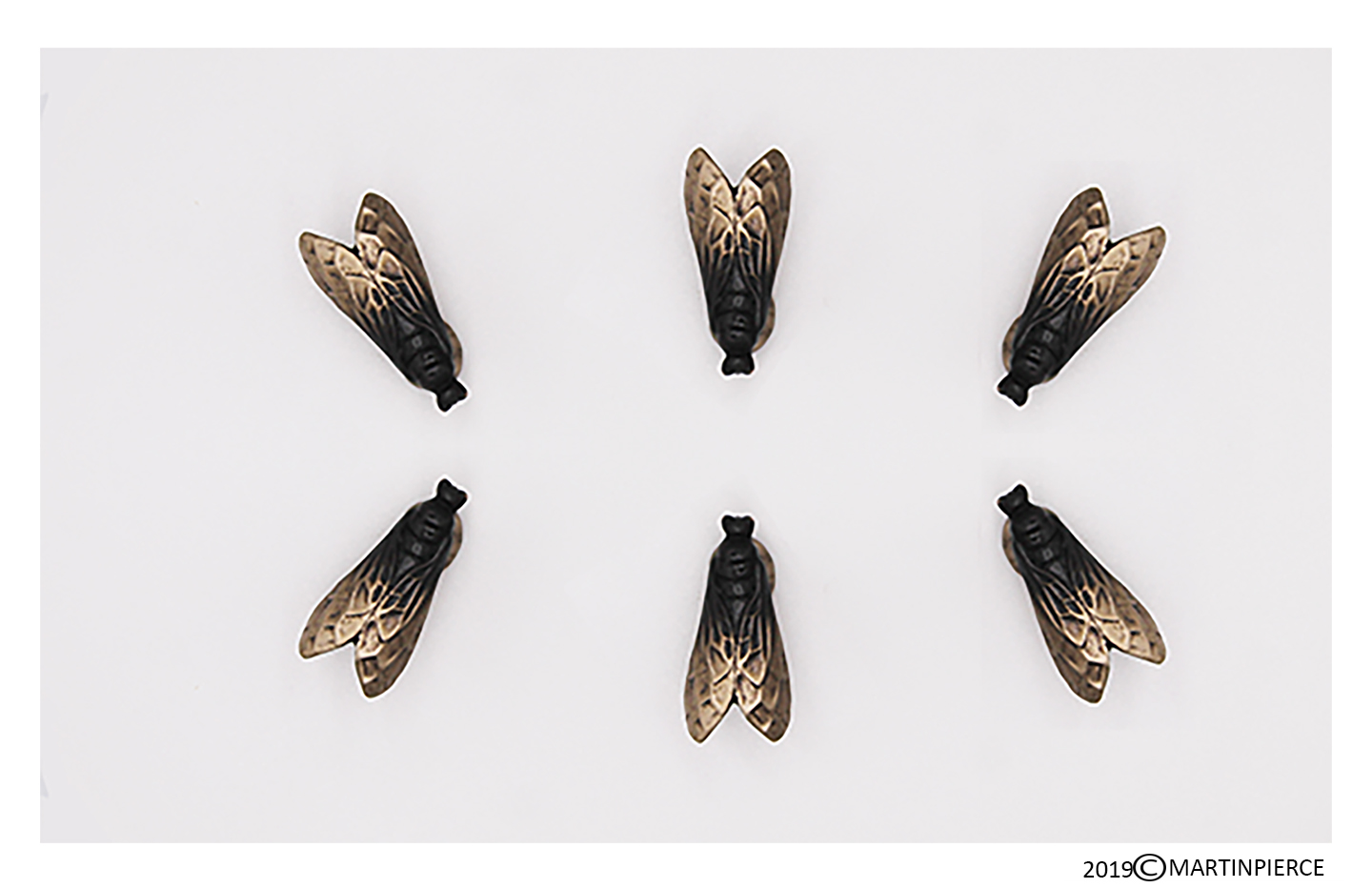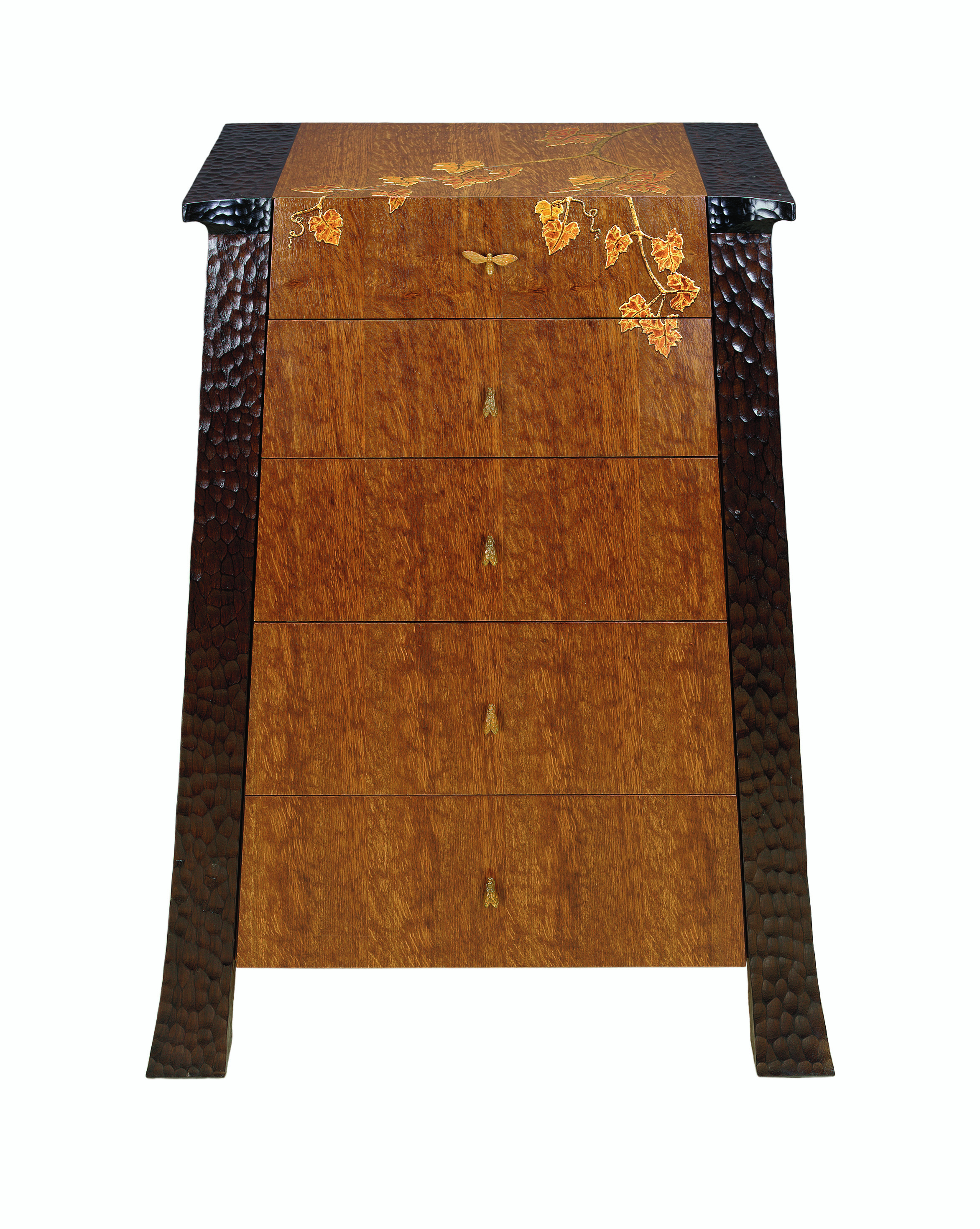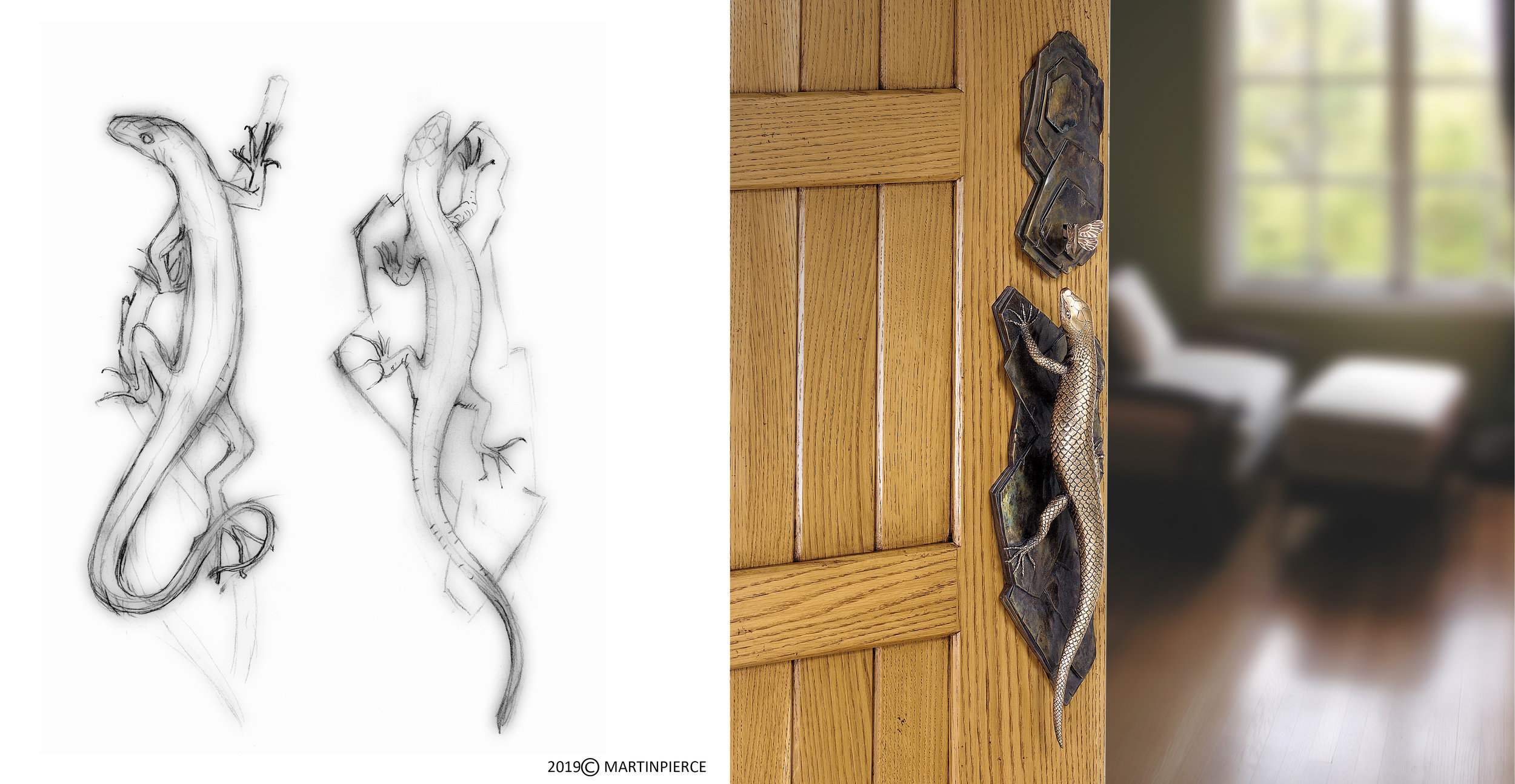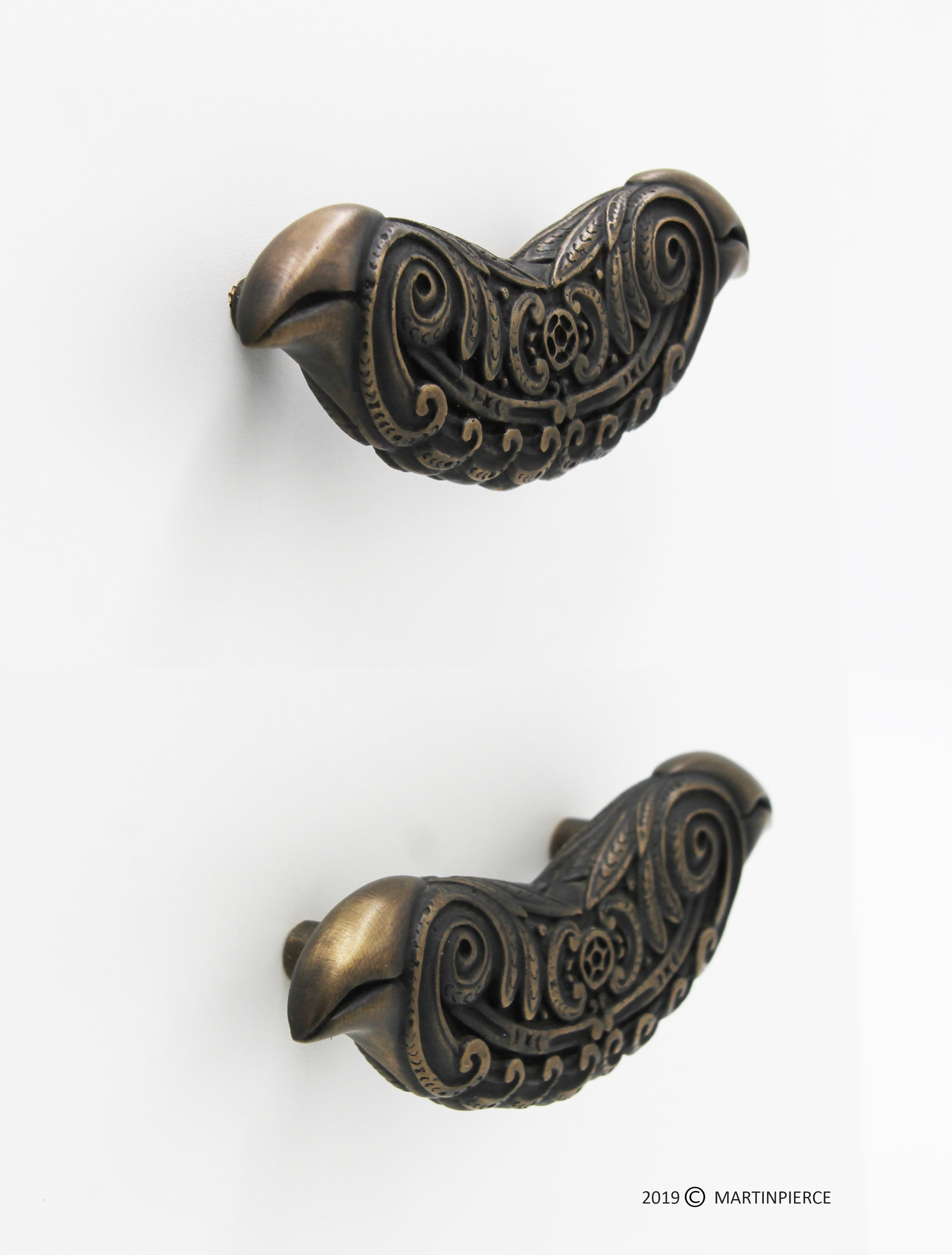Fear not this Halloween our bats will not entangle your hair nor slippery toads crawl up your legs as our creatures are cast in weighty bronze.
Let the witching hour commence!
Oil rubbed bronze door hardware and living finishes
The corrosion resistance of bronze makes it an alloy well suited for exterior door hardware. Over time with exposure to the elements bronze develops a patina which will continue to age and become darker. This living patina is a film of oxide which develops on the surface and helps to protect the bronze substratum.
We can simulate this process by applying an acidic solution to our prepared bronze (see other posts on Birchwood M20). The acidity of the solution will rapidly darken the bronze creating a film of oxide in a matter of minutes rather months or years. However, even though the bronze has been patinaed the oxidation process will continue and the patina will continue to darken and even become verdigris in color hence the phrase “living patina”.
Can the patina be fixed so that the color of the bronze does not change?
The oxidation process can be slowed down by sealing the surface with wax or by baking on either a clear enamel of lacquer finish. The latter method is one we turn to for more commercial projects and public areas where our handles will be touched constantly.
The knob or lever of a bronze handle set will become naturally burnished in those area where it is touched to open or close a door. As the escutcheon plate typically doesn’t get touched to the same degree, this area will continue to become darker. For our more textured handle sets we simulate this effect by using different acid immersion times for the knob and plate and further accentuate this contrast be burnishing key areas like the lizard’s body shown here.
Frogs and Toads for Halloween Treats
Frogs are one of 3 creatures in our door hardware collection that spring to mind as spooky Halloween draws near. Our Raven and Bat sculptures will make their appearance in later posts but now the spotlight shines down on our amphibian friends of the warty and smooth varieties.
Our frog doorknob bears warts that are more typical of their dry skinned shorter legged toad cousins. When Martin modelled the frog doorknob, he wanted to add a textural element that would also give the frog a grumpier persona and for the naturalists amongst us it should be noted that in nature quite a few frogs do have bumps.
The Halloween connection for Frogs is attributed to Shakespeare’s song of the witches from Macbeth where this ill-fated creature is added to the cauldron for the witch’s brew. In folk lore, contact with the bumpy epidermis of frogs when accompanied by the right spell could inflict warts on one’s victims.
The frog doorknob shown hear is mounted on a wreath of entwined willow leaves and being cast in bronze can be finished with a simple oil rubbed patina or with a hot patina to create verdigris.
Our smooth skinned frog cabinet pull is equally versatile and with the right hot patinas can be transformed to look like the poisonous dart frog found in the rain forests of central and south America.
How to add some fun to your kitchen remodel
How to add some fun to your kitchen remodel
To provide a better understanding of our small insect and reptile cabinet pulls we will over the next few months be photographing these little creatures form different perspectives. The hope is that this will help homeowners plan how and where to use these pieces and have a little fun in the process. We have typically photographed these pieces straight on and not surprisingly this is how they have been used on cabinet door and door fronts.
Cabinet pulls are typically thought of as being directional pieces but in nature tree frogs which our sculptures are based on are not directionally restrained.
The first image shows the profile, rear and aerial view of the left and right frog sculptures.
The second image shows how these 2 frog sculptures could be arranged in a leap-frog formation going up and down the cabinet door and drawer fronts. Given the whimsical nature of these pieces we feel you can indulge your sense of fun when tackling the more serious task of a kitchen remodel.
The frog pulls shown here were cast in solid bronze and finished with a light antique patina which we strategically removed to create highlights which accentuate the very 3-dimensional nature of these pieces. All our cabinet pulls are sculpted as three-dimensional art pieces and each facet is refined to create a piece that is attractive from all sides.
Artistic kitchen ideas,Frog pulls,Pulls for kitchen cabinetry,Whimsical door pulls,animal cabinet pulls
New Trends in Door Hardware
As a small, hands- on company, it is not difficult to spot trends at their out-start.
This is certainly the case with recent orders for barn door handles that are two tone with black or very dark brown accents. Our large door pulls, or grips are available in silicon bronze, an alloy that is golden or champagne in its unadorned state and in 316 stainless steel, an alloy which is a cool grey when cast.
Both alloys are durable, rust resistant and high- quality mediums but their density dictates how each can be color accented. Stainless steel is a much harder medium than bronze and its surface is more difficult to penetrate so liquid patinas will tend to slough off and not adhere to the metal. While bronze is a strong alloy its surface is easier to buff so liquid patinas can more easily penetrate and bind to the alloy.
Black is the color of choice for most tracking currently being sold for sliding barn doors which explains why we are seeing an increasing demand for black highlights to be added as custom finishes to our steel and bronze door grips. As our large door handles are dramatic organic designs, we feel it is important that the color accent be integrated into the design. When we are adding a dark patina to bronze handles, we immerse the piece in a chemical solution until it reaches the required darkness and then we halt the process by immersing the handle in water. Once dry, we re-work the piece by hand sanding and buffing the piece in select areas to remove the dark patina. The process can be repeated so that different depths of color are created. Once complete the color is fixed with penetrating oils and with a hard-wax topcoat. For high traffic projects the handle can be further protected by baking on a clear enamel coating.
We add color to stainless steel by baking on a powder chosen for color and iridescence. The handle is buffed or polished to the desired luster and areas that are to be free of color are masked off from areas receiving color. The color powder is sprayed on to the piece and then baked. Determining the accented area is crucial as once baked it is extremely difficult to rework the finish without stripping the piece back to the base metal.
Color by Light or Powder - the different types of colored door handles
We have a variety of door handles that are illuminated, and these are often ordered by those in the hospitality industry looking for accent piece for public areas. This was the case when we were commissioned to create custom large door handles based on our Morphic door pull design.
The client chose a very specific shade of blue which was their brand color, and which reflected the watery environment of their resort. Sea creatures were the inspirational basis for the custom Serpentine and Scroll pulls we designed and fabricated for the resort. The blue background of this piece is created by skillfully powder coating just the interior and by careful masking the face.
Our Coral and Fish illuminated pulls are colored by color diodes that are contained inside the LED light strips that are housed behind the face of the design. The advantage of this form of color is that the different color diodes allow the panel to be programmed for a variety of different color cycles. While the LED panels offer a wide range of color the door must be one that has been constructed with a hollow channel so that wire can be passed along the channel and connected to the panels wiring.
The photos below show these two methods for adding color. The Scroll pulls on the left were treated with an adhesive on the inside only, the face of the handle was masked with a releasing agent and the powdered handle was baked at a high temperature. The coral and fish pulls have color changing diodes and can be set for a specific color or programmed to go through color cycles.
.
Choosing Cabinet Handles for Children
We have just had the pleasurable task of helping a very thoughtful parent select suitable cabinet handles for his children’s game closet. The cabinet was fronted by 2 outward opening large doors behind which were 6 sets of smaller double doors housing a variety of games.
What I found especially pleasing was the way an eclectic but related theme of handles was chosen with each child receiving his/her pair of handles. The cabinet pulls were chosen from our animal inspired collection and were all finished in a soft light antique oil rubbed finish.
The result was a very artful collection of pieces reminiscent of the specimen cases of 19th century entomologists.
Two larger Polynesian inspired pulls were chosen for the main cabinet doors, the pulls are very thought provoking as the design is a fusion of bird, vine stem and even human features all of which flow together to create an abstract mythical piece. Cast in solid bronze, the pull is affixed top and bottom with 2 substantial 1 1/4” tall 5/8” diameter threaded posts which provide good clearance from the front of the cabinet making it an easy piece to grip.
While the pieces chosen should make for some engaging conversations, they were not designed for any specific audience but rather reflect Martin Pierce’s fascination with animals and insects.
The piece shown below is one that Martin did design for children and one that he had immense fun making although the Bombay shape and the characters portrayed in the parade challenged his skills both as a wood carver and storyteller.
Irrepressible nature and it's formidable roots
We have just returned from Quebec and wanted to share some of the non-architectural gems from the province’s national parks.
In the previous email we focused on the grandeur of the mountains and the power and beauty of Jacques-Cartier river, here we focus on the irrepressible trees that claim their space on this varied terrain.
The image below shows how the roots of a Birch tree forced their way through granite boulders and encapsulated this rock to make a weighty root bulb.
Aspen and birch tree roots intertwine to create natural step edges to this path made by nature and refined by animals including the human variety.
When visiting Kauai in December 2016 we noted how the banyan tree acts in a similar way to carve out a habitat to support it’s limbs.
The unruly entwined roots of the Beech trees of wind-swept Cornwall were the source of inspiration for the Hedgerow tree which is the signature piece in this organic collection of door handles. The handle pattern was carved in basswood in 4 sections with gnarled limbs and deep crevice forming the root bulb of this piece. The handle is formidable, cast with 8lbs of bronze and standing 19” high.
Quebec an inspiring Canadian Province
We are taking our annual respite from hot congested Los Angeles and the demands of making door hardware to visit lush Quebec, a province with easy to access unspoiled parks.
Parc national de la Jacques-Cartier is named its impressive and varied river whose turbulent rapids and gentler currents host a variety of fish and bird life. The park is a mere 45 minute drive from old Quebec city and has many well maintained trails suited to all levels of hiker. Feeling adventurous, we took the Les Loupes trail marked for the advanced hiker but manageable for the less advanced if frequent stops to regain ones breath are factored in. The trail goes up Sautauriski Mountain and provides a great Southern view outlook over the Jacques-Cartier river valley. Despite it’s name “ Les Loupes” this is not a loop trail (the word is French for wolf) but is a 10 km trail 5km there and 5 back. In the interests of factual reporting I must admit we only completed half of the trail and turned back to explore the river valley.
Martin Pierce on the Les Loupes (the wolf) trail.
Use this link for details on this park and its 200 plus trails visit
Gold Cabinet Pulls or Polished Bronze?
When is gold truly gold and when is it polished bronze? This is a tongue in cheek question and the answer reflects (pun intended) the high luster and jewel like appearance of polished bronze.
While we do occasionally gold plate our door hardware and while this clearly adds value to the item, for many, the appearance of gold is what is needed to create an accent to cabinetry.
Bronze is an alloy containing copper and this is what makes it a golden color. Copper and Gold are both elements on the Periodic table Cu and Au respectively and while they are both malleable and were used by early man they differ considerably in terms of scarcity and hence cost. A visit to https://www.jlab.org/ revealed that the “name Copper comes from the Latin Cuprum meaning “from the Island of Cyprus” which is where the Romans obtained the majority of their copper ore. The name gold comes from the Sanskrit word Jval and the Anglo-Saxon word gold.” Gold and bronze are both very soft mediums and in the case of silicon bronze tin and silicon are adding to copper to create a harder more durable alloy.
To create a highly polished surface the casting goes through 3 stages of progressively finer buffing;
First, we buff it using a high strength non-woven nylon disk on a mechanized buffing wheel, as the disk is not woven it is pliable and can buff irregular shapes. The material of the disk contains aluminum oxide a mineral that makes sharp very fine cuts into the surface of the bronze which helps to create consistent brush marks over the entire surface. We use a medium grit disk made by Standard Abrasives.
The piece is then hand polished using a 400-grit fine wet/dry sandpaper.
Lastly, we buff the pull on a cloth buffing wheel. Buffing compound is applied to the edge of the rotating cloth disk and when sufficiently coated the pull is pressed against the edge of the disk to create a high luster.
Limited Edition Door Handles
Limited Edition Door handles
We are a limited production company making finely detailed hand-made door hardware but our grapevine heroic door handle is a limited edition and here we examine both concepts.
All of our hardware is made using the lost wax method of casting and each piece is always chased by hand and finished by hand, which is a production process that simply does not work for industrial manufactures making 100’s or thousands of door handles. As artisans we are able to focus on smaller quantities which ensures that we can produce high quality unique and we hope more interesting pieces. In this sense our work is similar to that of the boutique or small winery who by virtue of their size are able to put more care into their craft than larger wineries.
Continuing the analogy the Grapevine Heroic door pull is akin to a small celebratory edition of wine where the number of bottle is limited to a few cases. The door pull was designed as a statement piece for wine collectors and is scaled for large wine cellar doors. The pull is made with the same care as any other piece but it’s scale, design and complexity warranted the added value of a finite edition of 100 pieces. Being 42” high and with 3 intricate sections the waxes are made personally by Martin Pierce who shapes and refines the smallest of details so that each piece is truly unique. Each piece is numbered and signed by Martin at the wax stage and we are currently at number 15.
Our hardware designs evolved from our work as furniture makers where we offered limited editions for the Vine Highboy (100) Aspen Buffet (30) and Aspen armoire (50).
The small number of the edition and the price point ensure that the edition will take several years to complete with each piece being fresh to the artists eye.
Using a heated scalpel and hand chisel Martin removes small imperfections from the wax
Custom door handle spindles for very deep doors
Our door handles are made to order here in Los Angeles. Once a door handle set has been cast and before any patina is applied the pieces must be machined and assembled according to the door specifications. While previous posts have explained how back-sets and handing affect the choice of components little has been said about how the thickness and material of the door can impact the choice of door spindle.
In the context of door handles and accessory door hardware the spindle is a metal rod that passes through the door and can be used to perform different functions;
a. Act as a connector to connect the 2 knob/levers of the handle set and to turn the tubular latch.
b. As a connector to a turn piece that will pass mid-way through the door to turn or throw a latch bolt.
c. To connect door knobs/levers where there is tubular latch that can be locked or unlocked using a pin that is pushed in or pulled back. In this instance, one half of the spindle swivels so that when turned the knob or lever will unlock the door typically from the inside as would be the case in a powder room. A half swivel spindle also enables a door to be opened where a mortise lock is used, in both these cases only half the spindle swivels otherwise the door could be opened from both sides. As a side note to keep the knob or lever on the swivel end taught an auxiliary spring is trapped at the end of the spindle and placed under pressure part way into the center of the spindle, this keeps the knob in place despite the frequent rotation of the spindle.
I am reluctant to ever use the word “standard” in any hardware context, but interior doors are often 1 3/8” or 1 ¾” deep and we would use respectively a 2 ½” and 3 ½” spindle.
A Hedgerow passageway knob set has just been ordered for a 5” thick door and so we are making 2 custom spindles, one at approximately 8” for the knob set and the second at 6” for the turn piece described above which is shorter as it will only be passing through half of the door. The door is unusually thick as both sides will be upholstered adding a pliancy element to the equation that may impact the final door thickness. As the upholstery is likely to contain soft padded material the installer may need to shorten the spindle, so the fabric is compressed slightly around the escutcheon so that the knobs are sufficiently tight.
Dragonfly beauty with efficiency
We now have a water feature at home so Martin spends a lot of time taking shots with his zoom lens of insects that it attracts and this weekend he was able to capture 2 mating dragonflies and the resulting beginnings of their progeny.
Martin uses a 28-200mm zoom lens and the details he caught of this dragonfly couple were not fully seen until they were uploaded onto his iPad. The couple mated on the wing for a brief couple of minutes and then the female dipped her ovipositor into the pond to disperse her eggs. The speed of the mating and egg deposit took us by surprise and we are impressed by the staggering efficiency of this reproductive cycle.
When the pictures were uploaded on Martin’s iPad we could appreciate the intricate beauty of this flying red wonder. The wings look like fragile window- panes
Having mated the female hovered over the pond and selected a location to lay her eggs.
She then deposited her eggs into the pond with her ovipositor which she also used to disperse her eggs.
Click and enlarge to fully appreciate the intricate detail of these window-pane wings that we cannot see with our naked eye.
Our bronze dragonfly maybe a poor facsimile of nature but we have tried to capture as much detail as possible in our bronze cabinet knob that weighs a hefty 2 ounces and that is colored with a hot red brown patina.
What is the best medium for door hardware patterns
There is no correct answer to this question, but your choice will depend on your method of designing and your skill sets. The broad choice is between creating a pattern using traditional carving or modeling techniques versus 3D designing and printing.
Traditional techniques -
You can create a solid pattern by modelling the design in clay and by adding and removing clay to obtain the desired shape. We are sculptors by training and create our patterns using wood or jewelers wax or high-density rigid foam. Basswood carves well as it is a close grained soft wood but the grain is distracting, and its directional nature means you have to be an adept carver changing direction with your chisels as you follow the grain. When the wood pattern has been carved, we typically coat it with a matt grey primer which both fills the grain and helps us see any imperfections that need to be carved out and sanded. While Jewelers blue wax is dense and one can achieve good detail it is not as strong as basswood and is more brittle which makes it less ideal when creating fine deep lines. Moreover, even though free of grain it has a uniform color that has a pronounced sheen both of which make it difficult to see what has been carved.
As both wax and wood have drawbacks, we find ourselves increasingly turning to high density rigid foam a product often used in the film industry by set designers to create props. This medium is light weight, dense, grain-less and matt and carves beautifully. It is available in blocks and easy to cut and glue and moderately priced.
The Hawaiian bird pulls were ordered recently by designer Christina Hilt in Florida in warmer tones to compliment the golden burl wood in her client’s closet. A dark patina accentuates the detail in a piece but if the pattern is carved with a deep relief carving then these details will still be seen even where there is minimal patina and minimal tonal contrast as was the case with Christina’s order.
Pattern in high density foam with foam block
Contemporary 3D pattern making
If you are adept in digital designing, then you would begin by designing your pattern in illustrator or Painter or other 3D program. On completion the design would need to be output as a STL file which could then be printed as an SLA print which is a photo polymer
Custom designs made by adapting existing cabinet pulls - a pragmatic alternative
In previous posts we have explained why creating one-off custom pieces is expensive as it requires a 3-dimensional pattern to be made and then a one- or two-part mold, all of which takes considerable time and expense.
However, don’t be too downhearted as there is a pragmatic alternative, that is if you like one of our collections and have a creative mind.
Our hardware collections reflect a theme and while each collection embodies the same style the pieces are not simply smaller and larger versions of one pattern, but artistic adaptations of the style honed to fit a particular function and scale. A good example of what I mean can be seen by comparing 3 willow cabinet pulls, while all were designed for cabinet doors and drawers and all have flowing leaves each of the pieces is different and distinct and reflects a holistic approach to design.
Sometimes we find ourselves thinking like the pizza chef who is called upon to add extra basil but hold the anchovy. Using my culinary analogy and realizing that taste is obviously subjective I was presented with the challenge of making the large willow cabinet pull but with fewer extraneous leaves and with a concentrated leaf arrangement akin to the smaller cabinet version. We were also asked to see if we could grow the willow sprig so that it could be used as an appliance pull with a span of 16”.
Below you can see how we cut and pasted a left and right willow sprig at the wax stage and how we then melded the sections together to create a longer piece. At this point a minimal amount of time and expense has been spent on creating a new piece and if approved we will use this new wax pattern to create a bronze casting. Since this will be an appliance pull, we do not expect the order to be for more than a few pieces and for each casting we will go through the same cutting and pasting process. If the order had been for many units then we would have created a new permanent pattern from which a mold would have been formed so that hundreds of subsequent waxes could be made.
By making a left and right willow sprig in wax we were able to fuse the 2 to create a hybrid piece.
Nature inspired cabinet pulls
The yellowjacket wasp was the model for our open and closed wing wasp cabinet pull and was originally designed for the Ascot Highboy a furniture piece made by our sister company Martin Pierce Furnishings. In keeping with the yellowjacket we finished these pieces with a yellow oxide which we burnished along the wing veins to expose the golden bronze beneath.
The Ascot tallboy was a limited edition of 100 which was closed at number 78 in 2013. The piece was made using quartered English brown oak, selected for its rich brown amber hues and for it’s dark “leoparding” a term that refers to the darker spotted figuring. The open and closed wing wasps were patinated to compliment this distinctive wood.
Several years ago, on a road trip to Idaho, we stayed at Lake Pend Oreille and came across the bald-faced hornet which is a relative of the yellowjacket but being much larger it is referred to as a hornet. The black and white markings of this insect are why it is referred to as bald-faced rather like the way we refer to the “bald” eagle.
Our memory of the hornet’s markings influenced a recent order that called for a simpler black oxide patina. By restricting the black patina to the head and thorax and by burnishing the wings we were able to create a dramatic statement using a simple patina on a small piece.
The wasps are cast in solid silicon bronze and are part of our insect and animal collection of cabinet knobs.
The latest addition to our wine cellar hardware collection
Cabinet Pulls for smaller spaces – latest addition to the Grapevine Collection
Our holistic approach to door hardware is one of the reasons we like to design complete collections that allow the consumer to continue a theme from entry door, to interior door to cabinet pulls and bathroom accessories. It also means that we are constantly adapting designs to give the designer a more complete range of hardware to chose from.
Our collection of wine cellar door handles led us to design a vine leaf cabinet pull which at 6"W x 3"H x 1 1/2"D works well as a drawer or cabinet door pull. However, for smaller confined spaces we saw a need for a smaller piece and have just added a new complimentary vine loop pull. The loop pull measures 2 ¼”W x 1 1/4”Hx x and projects 1 ½”x making it easy to grip. The pattern for this petite piece was carved by hand from a block of blue wax which is typically used by jewelry artists to sculpt ring patterns. A simple rubber mold was made and then used to create red wax replicas which went through the casting process from shelling to pouring to chasing and were finally finished with a light antique oil rubbed patina.
We mounted the larger vine leaf and the new loop pulls on cabinet drawers that were made using a cherry wood for the frame and myrtle burl cross hatched with wenge for the panels.
These images below show the fine hand- carved details of the wax pattern. For smaller pieces blue wax is a good sculpting option and you can achieve quick results with good eye hand coordination.
HAPPY 4th OF JULY
This year to celebrate the 4th we decided to re-create or more accurately embellish the flag with some of our signature door hardware pieces.
We recreated the flag in Photoshop by replacing the 50 stars with 50 moths and by replacing the white stripes with hidden daisy flowers. The daisy cabinet knob is one of the pieces in our flora collection and using an over-exposed front view we wove together many of these to create a textured banner but you will have to search hard to find these daisies. For the red stripes we created a row of walking or is that crawling lizards and we added a red hue for whimsical effect.
Last year we celebrated the 4th by adding colored bands to our raven sculpture.
Enjoy the 4th.
The Design Process for Door Handles
Creating door hardware is a balancing act where artistic inspiration is balanced and refined to meet the practical demands of functionality.
Continuing from last weeks post I want to share some of the initial designs that were submitted to designer Debbie Zylstra for her client’s home in Kailua-Kona. Debbie was in the process of designing a home entertainment center in Koa wood and wanted to incorporate dramatic door pulls for sliding doors. The cabinet was grand in scale at a height of 9’ and the lizard heroic handles were considered as a possibility. These pieces are extremely realistic, and the client wanted something more stylized and original but in the reptile family so, pencil in hand, Martin sketched out the iguanas. Martin designed 2 interlocking iguanas which give the illusion of being 2 different pieces, but which use one iguana that is inverted to create a pair. To get a sense of proportion he then reduced the scale and inserted the design into a scaled drawing of the cabinet. The body and head of both iguanas project out from the cabinet door by 4” and the underside of each projects 1 ½” so that there is enough clearance for the hand to grab either the head or tail of each iguana to slide the pocket door open. The angle of the head, legs and tail were made so that the pair would interlock comfortably but leave sufficient space so that fingers would not be pinched.
Below are the original sketches for the first large reptile sculptures that are the central pieces in the Lizard collection. Given their realistic design Martin felt he needed to create a left and right facing lizard so that he could more naturally capture the movement of a pair of lizards. The pair was designed so that the head of the right lizard protrudes beyond the slate back-plate allowing the thumb to then be extended to depress the butterfly thumb piece and thereby release the door latch.
Polynesian Inspired Cabinet Knobs
I recently stumbled upon early drawings that Martin Pierce did when commissioned to create a series of Hawaiian door and cabinet pulls for a residence in Kailua-Kona. In this post I will focus on how he developed the Double Headed and Single headed bird knobs.
When commissioned the scope of design for the cabinet pulls was to create 2 types of knob one 6”W x 2”H for the drawer fronts and the other 2”W x 2”H for the cabinet doors in a style loosely described as “nature based Hawaiian”. There were no other parameters which left the creative field open for birds, fish, people and plants as design starting points. Martin decided to proceed in 2 directions with a plant theme and a bird-animal theme, the former resulting in the orchid collection and the latter with 2 bird head knobs. For the bird knobs Martin turned to surfing the web looking for examples of Polynesian folk art and what he came away with was an image of highly stylized geometrically detailed work. With these thoughts he focused on the heavy beaked Takahe bird found in New Zealand, the most southern point of geographic area that makes up the Polynesian islands. This ground living bird has a rather thick head and thick beak and using this as the end of the drawer pull he designed geometric semi circles spreading out from the eye to depict swells of feathers that also look like breaking waves.
With the cabinet knob the beak and eye remain the focal point of the design but here a spiraling sea shell is used to form the birds tail.

